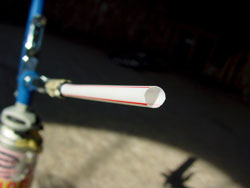Is it necessary to apply a vapour barrier to the 3”-thick foam installed on the insides of concrete basement walls? My step daughter and husband had a new house built, and are planning to finish the basement.

The short answer is yes, a vapour barrier is a good idea with some basement foam insulation systems. It all depends on the type of foam used and the tightness of the joints between neighbouring pieces of foam. I’ve seen situations, for instance, where heated basement air passes through cracks between otherwise impervious pieces of insulatingfoam, cooling as it hits the underlying concrete walls and condensing. In cases like this it’s not unusual for moderate amounts of condensed water to trickle out from behind the foam, running onto the floor.
 The best option is to fill any visible cracks with polyurethane foam from a spray can. If you push a drinking straw over the end of a foam gun and tape it in place you’ll be able to inject foam into smaller cracks in tighter quarters. Let the expanded foam harden for a day, then trim off the excess with a hacksaw blade taken out of the frame. For all the time it takes, I’d also put up standard, polyethylene vapour barrier before drywall, just to be sure there’s no trouble. The real danger that’s often missed when finishing basements is the area between the ends of floor joists where they meet outside walls. Applying spray foam to this area, or installing pieces of rigid foam with sealed edges, is the only option that reliably prevents condensation and mold.
The best option is to fill any visible cracks with polyurethane foam from a spray can. If you push a drinking straw over the end of a foam gun and tape it in place you’ll be able to inject foam into smaller cracks in tighter quarters. Let the expanded foam harden for a day, then trim off the excess with a hacksaw blade taken out of the frame. For all the time it takes, I’d also put up standard, polyethylene vapour barrier before drywall, just to be sure there’s no trouble. The real danger that’s often missed when finishing basements is the area between the ends of floor joists where they meet outside walls. Applying spray foam to this area, or installing pieces of rigid foam with sealed edges, is the only option that reliably prevents condensation and mold.



